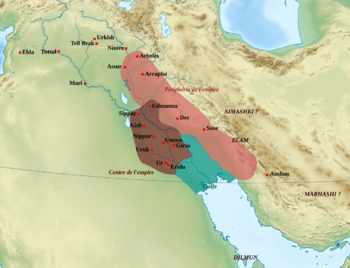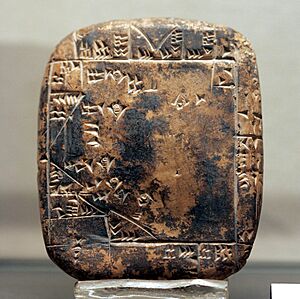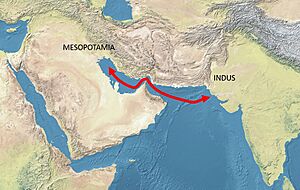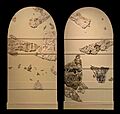Third Dynasty of Ur facts for kids
Quick facts for kids
Ur III dynasty
𒋀𒀕𒆠
URIM2KI |
|||||||||||
|---|---|---|---|---|---|---|---|---|---|---|---|
| c. 2112 BC – c. 2004 BC | |||||||||||

Map showing the Ur III state and its sphere of influence.
|
|||||||||||
| Capital | Ur | ||||||||||
| Common languages | Sumerian, Akkadian | ||||||||||
| Religion | Sumerian religion | ||||||||||
| Government | Monarchy | ||||||||||
| Lugal | |||||||||||
|
• c. 2112–2095 BC (MC)
|
Ur-Nammu (first) | ||||||||||
|
• c. 2028–2004 BC (MC)
|
Ibbi-Sin (last) | ||||||||||
| Historical era | Bronze Age | ||||||||||
|
• Established
|
c. 2112 BC (MC) | ||||||||||
|
• Lament for Ur
|
c. 2004 BC (MC) | ||||||||||
|
• Disestablished
|
c. 2004 BC (MC) | ||||||||||
|
|||||||||||
| Today part of | |||||||||||
The Third Dynasty of Ur, also known as the Neo-Sumerian Empire, was a powerful kingdom in ancient Mesopotamia. It existed from about 2112 BC to 2004 BC. This dynasty was based in the city of Ur, which is in modern-day Iraq.
Historians often call it Ur III for short. It's named after earlier dynasties of Ur, like the First Dynasty of Ur. However, there was no "Second Dynasty of Ur" that we know of.
Ur III was the last great Sumerian kingdom to rule Mesopotamia. It rose to power after the Akkadian Empire fell. Before Ur III, the region was controlled by the Gutians and other independent Sumerian cities. The Ur III kingdom controlled important cities like Isin, Larsa, and Eshnunna. Its influence reached far north into Upper Mesopotamia.
Contents
History of the Ur III Kingdom
The Third Dynasty of Ur began after the Akkadian Empire collapsed. The time between the last strong Akkadian king, Shar-Kali-Sharri, and the first Ur III king, Ur-Nammu, is not well known. Experts believe there was a short "dark age" with many cities fighting for power.
After the Akkadian Empire, invaders called the Gutians took over Mesopotamia. They came from the Zagros Mountains. The Gutians were nomadic people who didn't keep many records. When they were finally driven out, the region faced a severe famine. Their last king, Tirigan, was defeated by Utu-hengal of Uruk.

After Utu-Hengal's rule, Ur-Nammu became king and started the Third Dynasty of Ur. How he rose to power is not fully clear. Some records suggest that Ur-Nammu might have been a governor under Utu-Hengal.
Ur-Nammu became famous as a warrior king. He defeated the ruler of Lagash in battle. After this victory, he earned the title "king of Sumer and Akkad." This showed that Ur was now the most powerful city.
The Ur III kingdom became even stronger under Ur-Nammu with the famous Code of Ur-Nammu. This was likely the first set of laws for Mesopotamia since the time of Urukagina of Lagash.
Many big changes happened during the reign of Shulgi, Ur-Nammu's son. He worked to make the empire more organized and consistent. Shulgi standardized how the government worked, how records were kept, the tax system, and even the calendar. He also conquered the city of Susa and its surrounding area, defeating the Elamite king Kutik-Inshushinak.
Military Power and Conquests
In the last century of the 3rd millennium BCE, the kings of Ur fought many battles. These conflicts happened along the borders of their kingdom. We don't know exactly how their armies were organized.
The second ruler, Shulgi, greatly expanded the empire. His three successors continued to conquer new lands, but less often. At its largest, the Ur III empire stretched from southeastern Anatolia (modern Turkey) to the Iranian coast of the Persian Gulf. This shows how strong the dynasty was.
Hundreds of ancient texts describe how the Ur III armies seized treasures. These treasures were brought back to the kingdom after many victories. Shulgi's military campaigns were likely the most profitable. The kings and temples of Ur probably benefited most from these war spoils.
Conflicts with Mountain Tribes
The rulers of Ur III often fought with tribes from the Zagros mountain area. These tribes lived in the northeastern part of Mesopotamia. The most important tribes were the Simurrum and the Lullubi kingdoms. Ur III also frequently fought with Elam.
Rulers of Mari
In the northern city of Mari, Semitic military rulers called Shakkanakkus continued to rule. They were in power at the same time as the Third Dynasty of Ur. One of these rulers was Puzur-Ishtar, who was likely a contemporary of Amar-Sin.
Timeline of Ur III Rulers
Historians use different ways to figure out the exact dates for this period. There are two main timelines: the conventional (middle) chronology and the low (short) chronology. Here are the rulers and their approximate reign dates:
| Ruler | Middle Chronology | Short Chronology | |
|---|---|---|---|
| (Utu-hengal) | c. 2119 – c. 2112 BC | c. 2055 – c. 2048 BC | |
| Ur-Nammu | c. 2112 – c. 2094 BC | c. 2048 – c. 2030 BC | |
| Shulgi | c. 2094 – c. 2046 BC | c. 2030 – c. 1982 BC | |
| Amar-Sin | c. 2046 – c. 2037 BC | c. 1982 – c. 1973 BC | |
| Shu-Sin | c. 2037 – c. 2028 BC | c. 1973 – c. 1964 BC | |
| Ibbi-Sin | c. 2028 – c. 2004 BC | c. 1964 – c. 1940 BC |
An ancient document called the "List of Reigns of Kings of Ur and Isin" lists the kings of Ur and how long they ruled. It says: "18 years Ur-Namma [was] king, 48 years Shulgi [was] king, 9 years Amar-Suen, 9 years Su-Suen, 24 years Ibbi-Suen."
Fall of the Ur III Kingdom
The power of the Neo-Sumerians slowly grew weaker. In the 21st century BC, King Ibbi-Sin led military campaigns into Elam, but he couldn't go very far.
Around 2004 BC, the Elamites, allied with the people of Susa, attacked Ur. They were led by Kindattu, king of the Elamite Shimashki dynasty. They managed to surround and sack the city of Ur. King Ibbi-Sin was captured, and this ended the third dynasty of Ur. After this victory, the Elamites destroyed the kingdom. They ruled the area for the next 21 years.
Mesopotamia then came under the influence of the Amorite people. The Amorite kings of the Dynasty of Isin took over from Ur III. They started the Isin-Larsa period. They drove the Elamites out of Ur, rebuilt the city, and brought back the statue of the god Nanna that the Elamites had stolen.
The Amorites were nomadic tribes from the northern Levant. They spoke Northwest Semitic languages, which were different from the East Semitic languages spoken by the native Akkadians. By the 19th century BC, many Amorites lived in southern Mesopotamia. At first, they were shepherds, not farmers. But over time, Amorite grain merchants became important. They set up their own kingdoms in several southern Mesopotamian cities, like Isin, Larsa, Eshnunna, Lagash, and later, Babylon.
Daily Life and Organization
Political Structure
The Ur III kingdom had a system where the royal family was at the top. It was like a pyramid of households, with the king's family at the very top. All the kingdom's resources belonged to the royal family. Other families and groups were dependent on those above them. They provided labor to the royal family and received support, land, and protection in return.
In each province, two main leaders shared power. One was a governor (ensi), and the other was a general (Šagina). The general represented the king.
Each province had a center where taxes were collected. These taxes were called bala. The bala tax system rotated, so only one province supported the kingdom at a time. The amount of time a province supported the kingdom depended on its economy. Taxes could be paid with crops, livestock, or land. The government then distributed these goods as needed. This included funding temples and giving food to people who needed it.
The Holy City of Nippur

The city of Nippur was very important during the Third Dynasty of Ur. It was seen as the religious center of Mesopotamia. Nippur was home to the shrine of Enlil, who was considered the lord of all gods. It was believed that the god Enlil chose the king there, giving the king his power. This helped every king gain legitimacy.
People also brought their disagreements to Nippur to be settled, according to some ancient tablets. Politically, Nippur was not a military power. However, it was viewed as a "national Cult Center." Because of this, conquering Nippur was seen as too risky for Mesopotamian rulers. Being a holy site also helped Nippur survive many conflicts that destroyed other cities.
Social System and People's Lives
Scholars have different ideas about the social system in Ur III. For a long time, people thought that common workers were like serfs, meaning they were tied to the land. But new studies show a different picture.
Some groups of workers did seem to be forced to work. Others worked to keep their property or to get food from the state. However, many laborers were free men and women. They could improve their social standing. Many families traveled together to find work. These workers could even own private property and get promoted to higher jobs. This is different from the old idea that people could not move out of the social group they were born into.
Slaves were also a very important part of the workforce. Some experts believe that two-fifths of the slaves mentioned in documents were not born slaves. They became slaves because of debt, or because family members sold them, or for other reasons. Surprisingly, slaves in this period could sometimes save money and even own property. This allowed them to buy their freedom. Ancient documents describe how slaves negotiated their freedom with their owners.
An Early Code of Law
One important feature of Ur III was the creation of one of the earliest known law codes, the Code of Ur-Nammu. It is very similar to the famous Code of Hammurabi. Copies of this law code have been found in Nippur, Sippar, and Ur. Even though the introduction credits Ur-Nammu, some scholars think his son, Shulgi, might have written it.
The introduction to the law code says that the king was the source of justice for his land. This was a new idea, as earlier kings usually didn't play this role. The king claimed he wanted justice for everyone, including those who were often unlucky, like widows and orphans.
Most legal problems were handled locally by officials called mayors. However, their decisions could be challenged and changed by the provincial governor. Sometimes, legal disputes were discussed publicly with witnesses present, perhaps in the town square or in front of a temple. The idea of the king as the highest judge became very strong. This image appears in many stories and poems from that time. People sometimes wrote letters of prayer to the king, whether he was alive or had passed away.
Economy and Trade

The kings of Ur III managed many large projects run by the state. These included complex irrigation systems and organizing farming. A huge number of workers were gathered to work in agriculture. They focused on irrigation, harvesting crops, and planting seeds.
Textiles (cloth and fabric) were a very important industry in Ur during this time. The textile industry was controlled by the state. Many men, women, and children worked to produce wool and linen clothing. The detailed records from this period show a surprising amount of central control. Some scholars say no other time in Mesopotamian history reached this level of organization.
Trade with the Gulf Region
Trade was vital for the Ur Dynasty. It helped the empire grow its wealth and take care of its people. Mesopotamia traded with the Persian Gulf area. They mostly exchanged raw materials like metal, wood, ivory, and semi-precious stones.
One special item traded was conch shells. Craftsmen turned these shells into lamps and cups. These items date back to the 3rd millennium BC. They have been found in graves, palaces, temples, and homes. Since they were mostly found in wealthy places, it suggests that only rich people could afford them. Ur also used a lot of jewelry, inlays, carvings, and cylinder seals. The high demand for these items shows a strong trade relationship with the Gulf region.
Trade with the Indus Valley
There is evidence that goods from the Indus Valley came to Ur around 2350 BC. Objects made from shells found only on the Indus coast have been discovered in Mesopotamia. These date from about 2500-2000 BC.
Several seals from the Indus Valley, with their unique writing, have also been found in Mesopotamia. Many of these were found in Ur and Babylon. About twenty seals from the Akkadian and Ur III sites show connections with Harappa and often use the Indus script. This trade stopped when the Indus valley civilization declined after 1900 BC.
Art and Culture
Sumerian was the main language for culture. It was used for legal, administrative, and economic documents. However, the Akkadian language was also spreading. New towns built during this time were almost all given Akkadian names. Culture also flourished through many different types of art forms.
Literature and Stories
Many Sumerian texts were produced during the Ur III period. It's not really a "revival" because there's no evidence of a decline before this time. Instead, Sumerian changed. As the Semitic Akkadian language became the common spoken language, Sumerian continued to be used for literature and official documents. Government officials learned to write in special schools that only used Sumerian literature.
Some scholars believe that the famous Epic of Gilgamesh from Uruk was written down in its classic Sumerian form during this time. The Ur III Dynasty tried to connect themselves to the early kings of Uruk. They claimed to be related to them.
For example, the Ur III kings often said that Gilgamesh's divine parents, Ninsun and Lugalbanda, were their own. They probably did this to make people compare them to the epic hero. Another text from this period, called "The Death of Urnammu," describes a scene in the underworld. In it, Ur-Nammu gives gifts to "his brother Gilgamesh."
Images for kids
-
Stele of Ur-Nammu, at the University of Pennsylvania Museum of Archeology and Anthropology.
See also
- List of Mesopotamian dynasties
- Renaissance of Sumer









